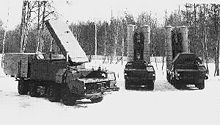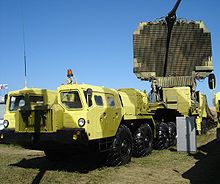S-300 (anti-aircraft missile system)
S-300 ( Russian С-300 - советский зенитно-ракетный комплекс ) is the collective name for a Russian anti-aircraft missile complex (FlaRak complex, also FlaRak system) of the Russian armaments manufacturer NPO Almas (today Almas-Antei ). There are a number of variants. S-300 systems were already designed in the Soviet Union to defend against or combat opposing combat aircraft and cruise missiles . Newer versions are suitable for fighting ballistic missiles and LO aircraft.
The first system S-300P ( NATO code name : SA-10A Grumble) entered service in 1978 by the Soviet air defense . Compared to the previous systems S-75 and S-200 , this complex is characterized by a phased array antenna and significantly more powerful electronics. The currently most modern variant is the S-400 system (NATO code name: SA-21 Growler), which was available around 2004 and represents a further development of the S-300 family.
overview
Since the 1970s, several different S-300 systems with different missiles, improved radar systems, improved protection against electronic countermeasures and higher accuracy, especially against low-flying targets and ballistic missiles, have been developed. There are essentially two main variants (S-300W and S-300P). The S-300F Fort was also developed on the basis of the S-300P.
| S-300 family | |||||||||||||||||||||||||||||||||||||||||||||||||||||
| S-300W | S-300P | S-300F | |||||||||||||||||||||||||||||||||||||||||||||||||||
| S-300W1 | S-300W2 | S-300PT | S-300PS | Away | Rif |
||||||||||||||||||||||||||||||||||||||||||||||||
| S-300WM | S-300PT-1 | S-300PM | Fort-M | Rif-M |
|||||||||||||||||||||||||||||||||||||||||||||||||
| S-300WM1 | S-300WM2 | S-300PT-1A | S-300PM1 | S-300PMU1 |
Fort M2 | Rif-M2 |
|||||||||||||||||||||||||||||||||||||||||||||||
Share 2500 |
S-300PM2 | S-300PMU2 |
Russian version | ||||||||||||||||||||||||||||||||||||||||||||||||||
| favourite | Favorite-S |
Export version |
|||||||||||||||||||||||||||||||||||||||||||||||||||
| S-300WMD | S-400 | ||||||||||||||||||||||||||||||||||||||||||||||||||||
S-300P

The S-300P complex ( NATO code name : SA-10 Grumble) was developed as a so-called long-range anti- aircraft missile complex primarily for air defense units and units ( Russian Войска ПВО / Woiska PWO) in order to achieve strategic targets against strategic airstrikes , but also to defend against cruise missiles . At the same time, the modification S-300PT-1 and S-300PT-1A were provided as mobile systems to protect the armed forces on the ground. It can fight air targets up to a distance of 75 km at a maximum altitude of 25 km.
S-300F
The S-300F Fort ( Russian Форт , NATO code name: SA-N-6) was introduced in 1984 as a ship-based version of the S-300P with the new 5W55RM missile. With 90 km and 6,120 km / h, the range and top speed were significantly increased. The summit height, however, was reduced to 25 km. The marine version uses various radar and radio remote control systems.
The system was installed and tested at sea on cruisers of the Kara and Slawa class . The 5W55RM missile is stored in six or eight missile-holding rotating missile launchers below deck.
S-300FM
The S-300FM Fort-M is another naval variant of the system (NATO code name: SA-N-20). With it, the new 48N6 rocket in the form of the 48N6Je was introduced in 1990. The top speed was increased to 7,560 km / h. The warhead mass of 150 kg and the maximum range of 150 km have also been increased.
The new missiles received a new guidance system to intercept short-range ballistic missiles.
S-300PMU-1
The S-300PMU-1 (NATO code name: SA-20A) was introduced in 1992. This version was created after evaluating the US experience in the Gulf War in 1991 . The S-300PMU-1 uses the larger 48N6 missiles. The system is designed to combat ballistic missiles.
S-300PMU-2
The current S-300PMU-2 Favorit (NATO code name: SA-20B; US DoD designation: SA-20B) was introduced in 1997. It is similar to the S-300PMU-1 and has the 48N6Je2 missile with a range increased to 195 km. It can intercept medium-range ballistic missiles.
S-300W
The S-300W system was developed for the air defense forces of the ground forces (army). All components are housed on tracked vehicles. The S-300W system is highly mobile and designed to combat ballistic missiles. When it was commissioned, the S-300W system was the first operational mobile missile defense system in the world.
S-300WM
The S-300WM system ( Antei 2500 ) is the significantly more powerful anti-aircraft missile system of the S-300W complex. The main innovation is the use of more modern radar systems, such as the 9S32ME fire control radar or the 9S15M2, 9S15MT2E or 9S15MW2E search radars . The system is also equipped with the modern 9S457ME command station. The Antei-2500 system can couple six 9A84ME launch vehicles, each equipped with four rocket launch containers. The system can protect an area of 2,500 km² from air raids.
Web links
- S-300 family at DTIG (English)
- S-300 in the Encyclopedia Astronautica (English)


